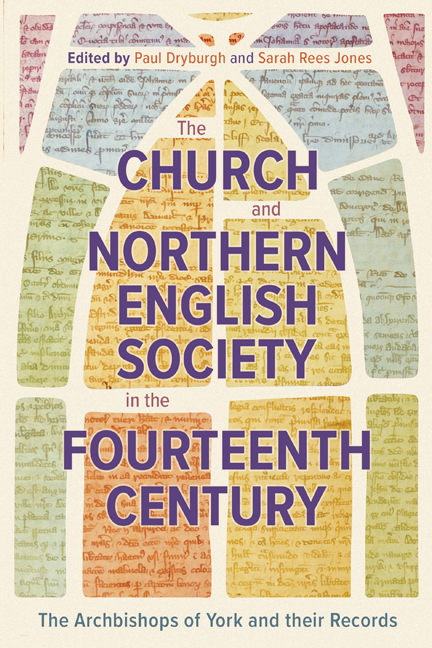 The Church and Northern English Society in the Fourteenth Century
The Church and Northern English Society in the Fourteenth Century Published online by Cambridge University Press: 17 May 2024
Few can have been the occasions when the fruits of labour in the archives of the medieval Church have graced the London stage. During the final month of 2019, however, sell-out audiences were treated to just such a spectacle in the form of a Christmas musical – ‘Joan of Leeds’. Written by Billy Barrett and Ellice Stevens and performed at the New Diorama Theatre by Breach Theatre, a young and innovative company, the play told the story of a nun – Joan – who escaped her convent, faked her own death and attempted to live a secular – sexually liberated – life in fourteenth-century, and later, twentieth-century, Yorkshire. Combining elements of the medieval mystery play, as performed by local amateurs, with a modern message, the writers of this hysterically funny piece also re-imagined Joan's character as one of devotion, but now with the message of a later discovery of self and sexuality. The production was based on a single entry, couched in forbidding, heavily abbreviated, rather florid ecclesiastical Latin, taken from the original register of William Melton, archbishop of York (1317–40), now held at the Borthwick Institute for Archives, University of York. Published in a full Latin transcript (with no translation) as recently as 2011 by Dr David Robinson in the sixth volume of the long-running edition of Melton's Register by the Canterbury and York Society, this entry, from 11 August 1318, records an order from Archbishop Melton to the dean of Beverley to issue a monition, or warning, to Joan of Leeds (Johanna de Ledis), a nun of the Benedictine priory of St Clement or Clementhorpe, York, to return to her house, and an order to pronounce a sentence of excommunication on her and to discover the names of her accomplices. The entry records that Joan had left her convent and travelled to Beverley, where she attempted to bring about her escape from the religious life.
Apostasy – in the monition, Joan is described as ‘apostatantem’ (‘apostatising’) – a breach of the vows of poverty, chastity and obedience that she had purportedly professed, involving casting off the habit of religion and wandering at large in secular society without authorisation and so risking excommunication, was not, as Donald Logan and Elizabeth Makowski have shown, an uncommon occurrence, and is a phenomenon regularly reflected in the records of the medieval English Church.
To save this book to your Kindle, first ensure no-reply@cambridge.org is added to your Approved Personal Document E-mail List under your Personal Document Settings on the Manage Your Content and Devices page of your Amazon account. Then enter the ‘name’ part of your Kindle email address below. Find out more about saving to your Kindle.
Note you can select to save to either the @free.kindle.com or @kindle.com variations. ‘@free.kindle.com’ emails are free but can only be saved to your device when it is connected to wi-fi. ‘@kindle.com’ emails can be delivered even when you are not connected to wi-fi, but note that service fees apply.
Find out more about the Kindle Personal Document Service.
To save content items to your account, please confirm that you agree to abide by our usage policies. If this is the first time you use this feature, you will be asked to authorise Cambridge Core to connect with your account. Find out more about saving content to Dropbox.
To save content items to your account, please confirm that you agree to abide by our usage policies. If this is the first time you use this feature, you will be asked to authorise Cambridge Core to connect with your account. Find out more about saving content to Google Drive.